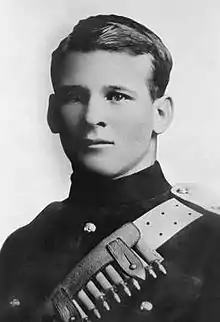5th Battalion (Western Cavalry), CEF
The 5th Battalion (Western Cavalry), CEF, known as "Tuxford's Dandys," was an infantry battalion of the Canadian Expeditionary Force during the Great War.
| 5th Canadian Infantry Battalion, CEF | |
|---|---|
 Distinguishing patch of the battalion | |
| Active | 1914–1920 |
| Disbanded | 1920 |
| Country | Canada |
| Branch | Canadian Expeditionary Force |
| Type | Infantry |
| Part of | 2nd Infantry Brigade, 1st Canadian Division |
| Mobilization headquarters | Camp Valcartier |
| Nickname(s) | Tuxford's Dandies |
| Battle honours | List
|
| Commanders | |
| Notable commanders | BGen George Tuxford |
History
The 5th Battalion was authorized on 10 August 1914 and embarked for Great Britain on 29 September 1915. It entered the theatre of operations in France on 14 February 1915, where it fought as part of the 2nd Infantry Brigade, 1st Canadian Division in France and Flanders until the end of the war. The battalion was disbanded on 15 September 1920.[1]
The 5th Battalion recruited in Brandon, Manitoba; Saskatoon, Regina and Moose Jaw, Saskatchewan; Red Deer, Alberta and Merritt and Vernon, British Columbia and was mobilized at Camp Valcartier, Quebec.[2]
The battalion fought in the attack on Vimy Ridge with 14 officers and 350 other ranks killed or wounded.[3]
The 5th Battalion had five officers commanding:
- Lieutenant-Colonel George Tuxford, 22 September 1915-January 11, 1916
- Lieutenant-Colonel H.M. Dyer, DSO, 11 January 1916 – 29 June 1917
- Lieutenant-Colonel L.P.O. Tudor, DSO, 29 June 1917 – 8 March 1918
- Lieutenant-Colonel L.L. Crawford, DSO, 8 March 1918 – 4 April 1918
- Lieutenant-Colonel L.P.O. Tudor, DSO, 4 April 1918-Demobilization[4]

Sgt. Raphael Louis Zengel of the 5th Battalion was awarded the Victoria Cross for his action on 9 August 1918 at Warvillers, France. He had previously been awarded the Military Medal.[5]
The 5th Battalion was awarded the following battle honours in 1929:[6]
- YPRES, 1915, '17
- Gravenstafel
- St. Julien
- FESTUBERT, 1915
- MOUNT SORREL
- SOMME, 1916
- Thiepval
- Ancre Heights
- ARRAS, 1917, '18
- Vimy, 1917
- Arleux
- HILL 70
- Passchendaele
- AMIENS
- Scarpe, 1918
- Drocourt-Quéant
- HINDENBURG LINE
- Canal du Nord
- PURSUIT TO MONS
- FRANCE AND FLANDERS, 1915-18
The perpetuation of the 5th Battalion (Western Cavalry), CEF, was initially assigned in 1920 to 1st Battalion, The North Saskatchewan Regiment, and has been passed down as follows:[1]
- 1st Battalion, The North Saskatchewan Regiment: 1920–1924
- 1st Battalion, The Saskatoon Light Infantry: 1924–1936
- The Saskatoon Light Infantry (Machine Gun): 1936–1955
- The North Saskatchewan Regiment (Machine Gun): 1955–1958
- The North Saskatchewan Regiment: 1958–present
References
- Department of National Defence (2018-10-29). "The North Saskatchewan Regiment". Retrieved 2020-11-28.
- Meek, John F. Over the Top! The Canadian Infantry in the First World War. Orangeville, Ont.: The Author, 1971. ISBN 0906158109
- Cook, Tim (7 March 2017). Vimy. Allen Lane. ISBN 0735233160.
- Meek, John F. Over the Top! The Canadian Infantry in the First World War. Orangeville, Ont.: The Author, 1971. ISBN 0906158109
- Meek, John F. Over the Top! The Canadian Infantry in the First World War. Orangeville, Ont.: The Author, 1971. ISBN 0906158109
- Appendix to General Order No. 110 of 1929. 1929. p. 20.
Sources
- Canadian Expeditionary Force 1914-1919 by Col G.W.L. Nicholson, CD, Queens's Printer, Ottawa, Ontario, 1962
- 5th Battalion, Canadian Expeditionary Force Study Group
External links
| Wikimedia Commons has media related to 5th Battalion (Western Cavalry), CEF. |